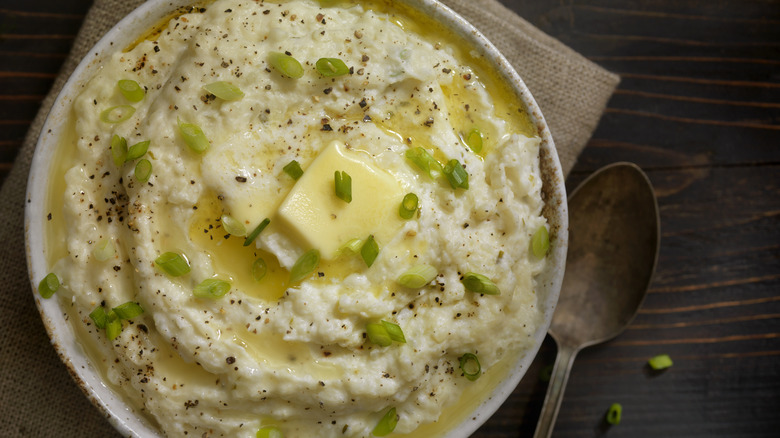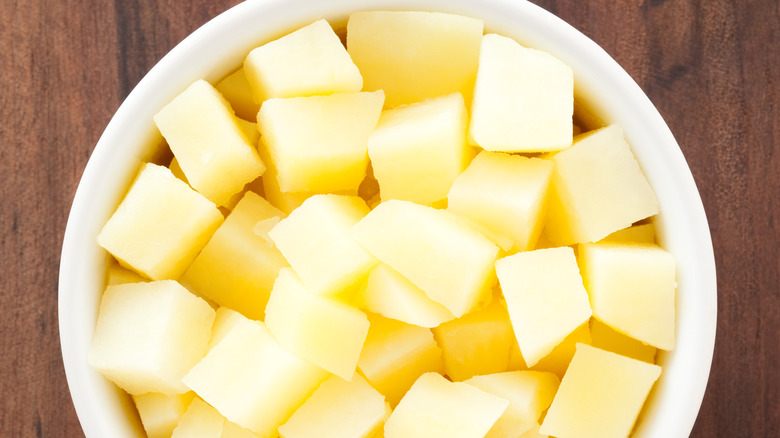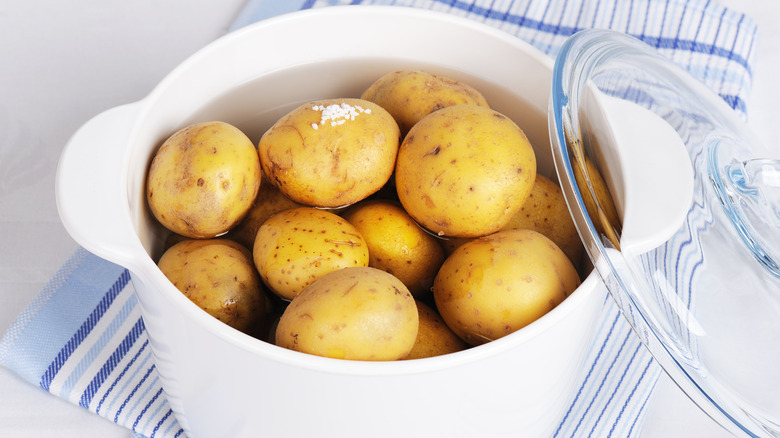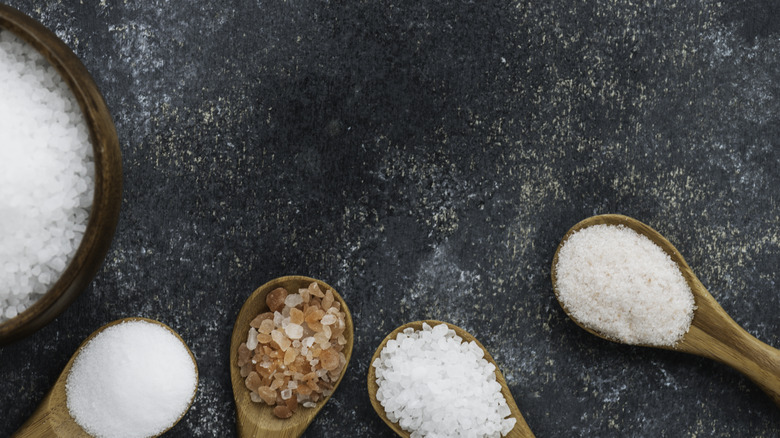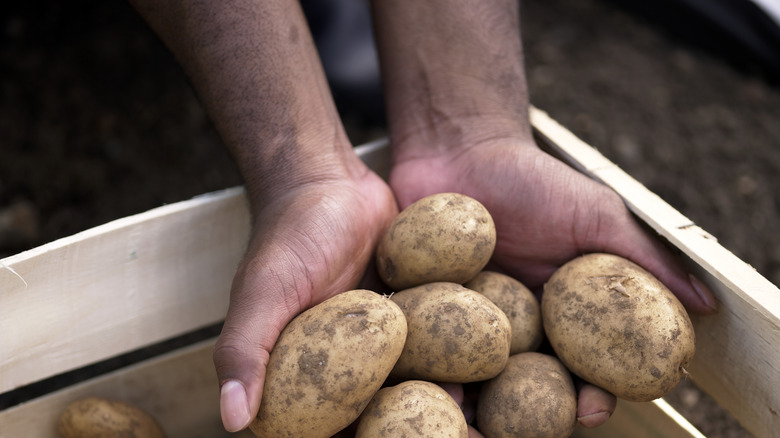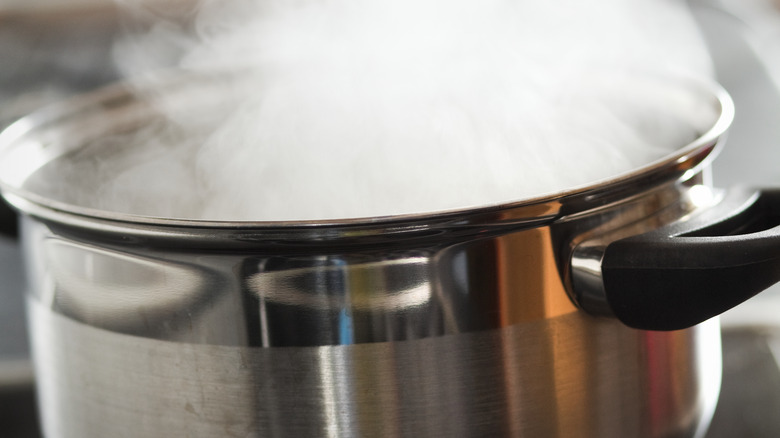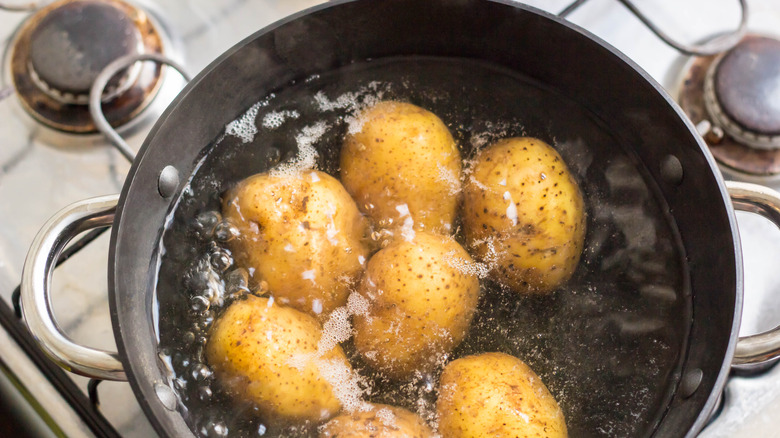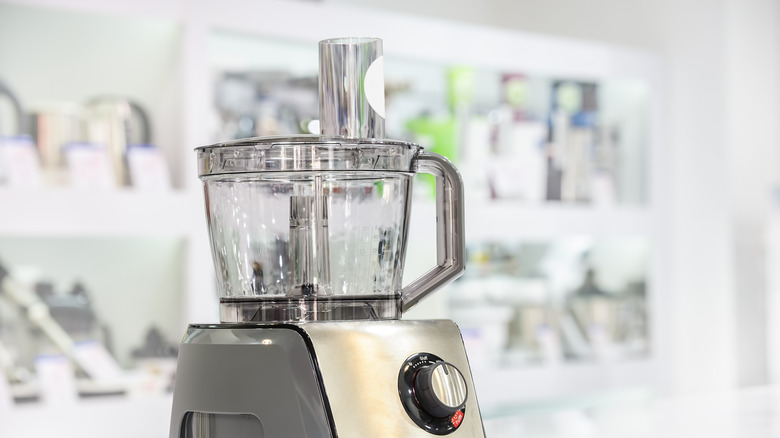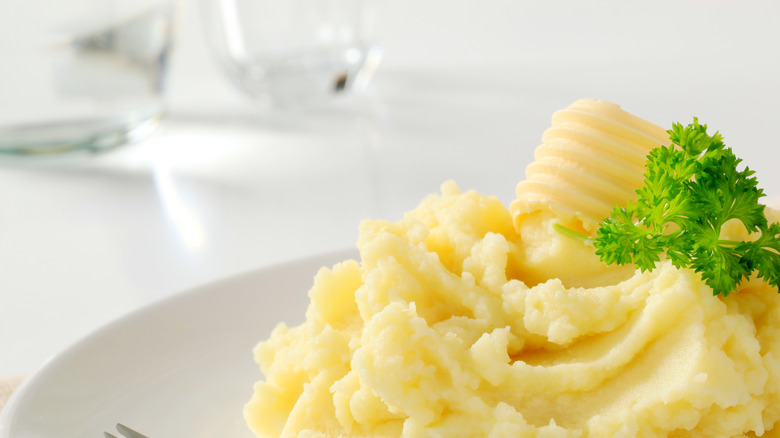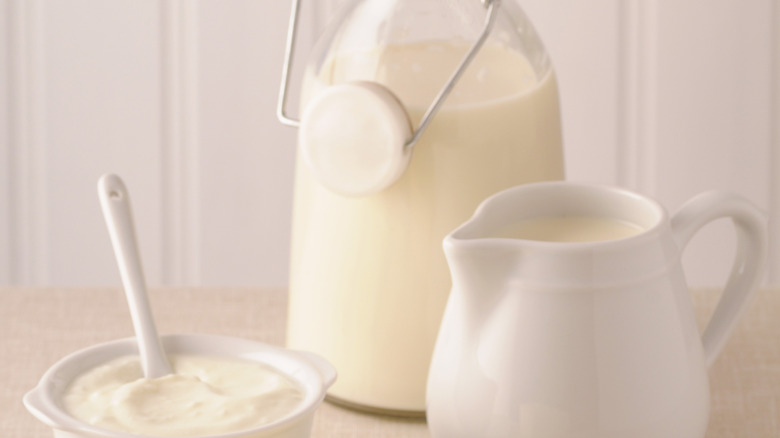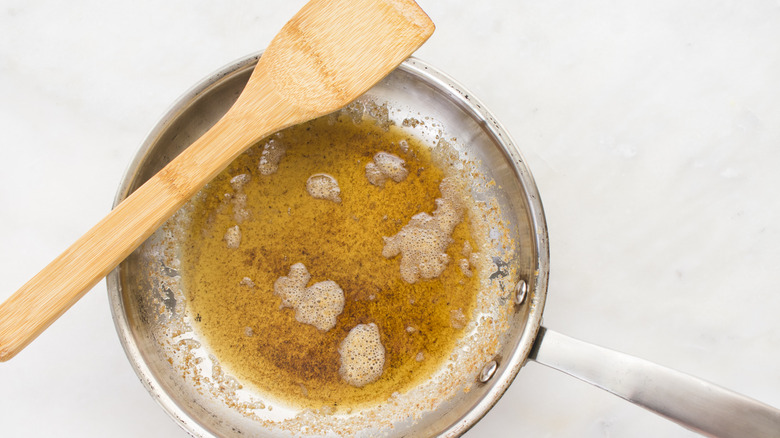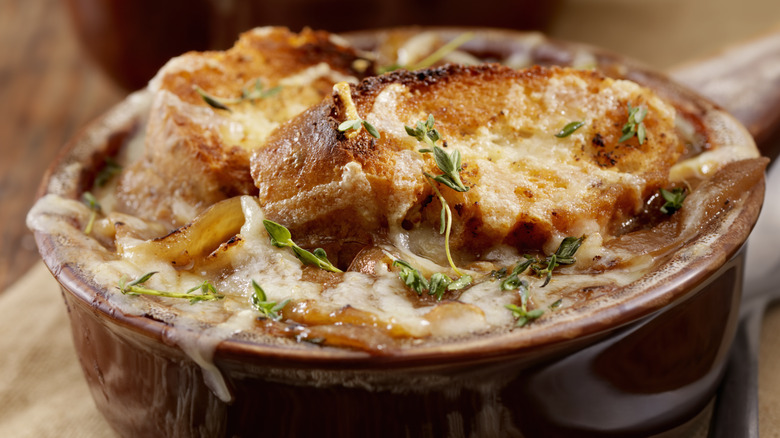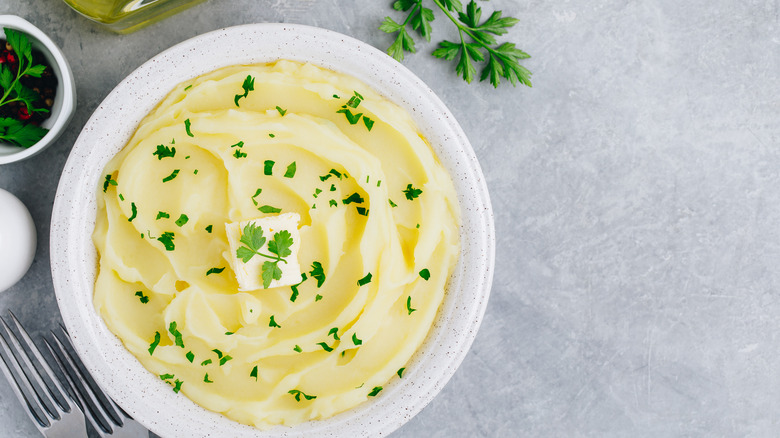The 12 Mistakes Keeping You From Perfect Mashed Potatoes
The perfect mashed potatoes are a study in technique. Sure, they may only require a scant number of ingredients (all of which happen to be humble, affordable pantry staples), but they are so much more than the sum of their parts. Their simplicity belies the trickiness of getting it just right. And with so few elements, there's nothing to hide behind. A small mistake in preparation can lead to lumpy, gluey potatoes rather than silky, smooth, fluffy ones.
Done properly, mashed potatoes should be seasoned evenly throughout and dressed up with just enough fat to add richness without heft. They should be warm. They should be light, creamy, and buttery. They should never be dense or leaden or pasty. And while that may sound like a tall order, most of the magic of perfecting your mashed potato technique comes down to understanding and taming the starch in the potatoes. Starch is what determines the consistency of your mashed potatoes. Learn to control how much starch is released during the cooking process, and you'll be on your way to mashed potato greatness.
1. Not cutting your potatoes before boiling
As potatoes boil, they release some of their starches into the water. Think of it like pasta: The water in the pot becomes a wonderfully starchy liquid that makes a perfect base for thickening sauces. You might think it's better to boil the potatoes whole — after all, don't you want to keep all that starch if it's so useful? In this case, no. Potatoes are far starchier than pasta, and excess starch is what makes some mashed potatoes gummy and gluey. The trick to perfectly silky mashed potatoes is nailing the balance of starch. Too much makes an inedible, dense dish. Just enough yields a fluffy pile of potatoes. Cutting the potatoes before boiling helps to release the proper amount of excess starch; aim for about a 2-inch dice on your potatoes for the optimal ratio of water to surface area.
2. Peeling before boiling
Now that we've established that the secret to great mashed potatoes is all about nailing the starch balance, let's get into peeling. After the potatoes are cooked, you will add butter (or another fat) and milk to achieve that beautifully creamy, spoonable texture. If you peel the potatoes before boiling, you remove their protective layer. This creates two issues.
First, it allows the potatoes to shed too much starch (remember, we want starch, just not too much of it). Second, it allows the potatoes to absorb more water. If you keep the peel on, it acts as a barrier against the absorption of water. If the potatoes take on too much water, they're all saturated and won't be able to absorb as much fat and milk later on in the preparation process. You'll end up with watery potatoes instead of creamy ones.
3. Not seasoning along the way
Any cook worth their salt — pun intended — knows to cook pasta in heavily salted water. "Make it taste like the sea," is the old cooking adage. This applies to potatoes too. You can always add a finishing salt to a dish, but sprinkling salt on top is never going to be a substitute for properly seasoning along the way. If you only add salt at the end of cooking, the potatoes will taste bland with a hit of salt at the end of each bite.
If you cook the potatoes in salted water, the potatoes will absorb the salt, so the seasoning is evenly distributed among every little bit of potato. You can also season in subsequent steps as you add fat and liquid. Taste as you go and season as needed. With each added ingredient, the balance of the dish will shift and you can compensate with salt.
4. Choosing the wrong potato
Deciding what makes the best potato for mashing comes down to the starch content. The "best" mashed potato is somewhat subjective (you might prefer lighter, airer potatoes, whereas another cook might consider denser, creamier mashed potatoes the very best), so understanding how various potatoes will behave when mashed will allow you to choose the ones that give you the result you're after. Potatoes with a higher starch content will turn fluffier when mashed and tend to stay drier. This gives you a good texture to your mashed potatoes.
A russet potato is the classic choice for a high-starch potato. Often called a "baking potato," these potatoes are referred to as mealy rather than waxy. As Harold McGee explains in his seminal book "On Food and Cooking," the cells of mealy potatoes swell and separate during cooking, yielding a drier and fluffier mash. On the other end of the spectrum, waxy potatoes (like Yukon golds) will yield a creamier, more luscious, and slightly more dense and silky result. Waxy potatoes have a lower starch content, and their cells will stick together rather than separate, creating a stickier texture.
5. Starting with boiling water
We've established that it's important to cut your potatoes into chunks before cooking. But even with potatoes in properly cut pieces, you run the risk that the outside will cook more quickly than the inside, leading to uneven cooking. This will make your mashed potatoes lumpy rather than smooth, as the inside pieces remain hard and not entirely cooked through.
The way to prevent this is to start with cold water. Cover your potatoes with cold, salted water and bring it to a boil. Once at a boil, reduce the heat and maintain it at a gentle simmer for the rest of the cooking time. By gradually raising the temperature, the potatoes will cook evenly throughout. Keeping it at a low simmer will eliminate the issue of the exterior of the potatoes cooking too quickly.
6. Not drying out the potatoes
So you've selected the perfect variety of potatoes, salted the water, cooked them gently in cold water, and brought them to a boil, and now you're ready to move on to the mash. Not so fast! Don't just toss those expertly cooked potatoes into a bowl and start going to town. Drain the potatoes, then pop them back into the same pot you used for cooking. Turn the heat to low (or extra low) and give them a few minutes more of cooking time. This will dry out any excess water on the potatoes.
Don't overdo it: Dried mashed potatoes are a big no. But if you allow too much extra water to carry over from the cooking process, it can leach out into the final dish and yield watery mashed potatoes. You don't want water taking up too much space, or the potatoes won't be able to absorb all the delicious fat and cream you're about to add.
7. Using a food processor to mash
Mashing is the most crucial step of the entire process. After all, there's a reason the verb takes center stage in the recipe title. There are a few ways to achieve a mashed consistency: You can do it by hand, or you can use a ricer, a food mill, or even an electric mixer. Whatever method you choose, do not be tempted to reach for the food processor. Why not? Even though a food processor is the go-to appliance for all sorts of silky purees, it's the enemy of a smooth mashed potato dish. The reason all comes down to starch.
Potatoes are made up of starch molecules, kept intact inside their cell walls. If you gently work the potatoes by hand or with a ricer, the cells remain intact. If you bring the potatoes into contact with very sharp blades, like a food processor or blender, the blades will shred the cell walls, releasing the starch. The starch mixes with liquid and creates a gooey, gluey mess. If you've ever eaten gloppy, gummy mashed potatoes, you've tasted firsthand how unpleasant the result is when the starch is released.
8. Thinking more mashing equals a fluffier result
Just as you don't want to use sharp blades on your potatoes, you also don't want to overwork the potatoes too much. Many cooks new to making mashed potatoes assume that the more you mash, the smoother the potatoes will get. Sure, this might work for a smoothie or when making applesauce, but potatoes are different. Overwashing and overworking the potatoes will also destroy the starch molecules' structure, creating that same unpleasant gummy texture that you'd get from utilizing a food processor.
But don't panic if you end up here by accident. You can always rescue the potatoes. You won't be able to resuscitate them into fluffy, smooth mashed potatoes, but you can repurpose them into a different, equally elegant dish: pommes aligot. This classic French potato is made by beating mashed potatoes with cheese and creme fraiche. Hefty amounts of dairy work with the starchiness and offset it. In fact, these potatoes are beaten for close to 10 minutes.
9. Adding cold liquid
When your potatoes are mashed and smooth, it's time to start dressing up the dish with dairy. This is the stage when you reach for butter and milk, mixing each one in gently to retain the silky texture without overworking the potatoes. We've all been in a rush before and grabbed a carton of cold milk or a cold stick of butter from the refrigerator, assuming that the heat of the potato mixture would melt the butter and warm the milk. And it will, but not without sacrificing a lot along the way.
If you add cold milk to the potatoes, the milk will cool down the temperature of the potatoes. This means the milk won't get absorbed evenly or properly. Instead, start with all the ingredients closer to the same temperature. Starting with room-temperature milk will allow the potatoes to absorb it more easily.
10. Opting for only butter
No one is going to argue against the merits of adding butter for flavor. Mashed potatoes are iconic because of all that delicious buttery taste. But you'd do well to think beyond one type of fat. Instead of relying on butter for flavor, consider reaching for a different type of fat to layer into the dish for more depth of flavor. Olive oil is an excellent choice with its grassy, green flavor.
If you want to stick with all butter, consider browning a portion of the butter first to create a nuttier, deeper taste. Simply divide the amount of butter called for in the recipe in half and brown half ahead of time. Swirl the butter in a pan over medium heat until it foams. The foam will subside, and small brown flecks will appear on the bottom of the pan. This is the visual evidence of the milk solids browning and will be accompanied by a wonderfully nutty smell. Remove the butter from the heat, pour it into a bowl, and allow it to cool to room temperature before adding it to your potatoes.
11. Skipping extra flavors
Simple is classic. Simple is traditional. But that doesn't mean that you should overlook the power of a few extra ingredients that can really amplify the earthy flavor of the potatoes and the creamy, rich flavor of the dairy and fat. Just as salt elevates all elements of a dish, so can a smartly chosen add-in. And if you want to go all out and really give your mashed potatoes a makeover, you can take that route by adding bolder, more standout ingredients.
If you want to go the more subtle route, add roasted garlic, chopped scallions, or freshly ground black pepper. Looking to take it up a notch? Make a twice-baked potato-inspired version with crumbled bacon, a dollop of sour cream, and a sprinkling of paprika. Or do a caprese version with chopped sun-dried tomato and torn bits of fresh mozzarella, which will melt slightly into the warm potatoes. Another French-inspired favorite is French onion soup mashed potatoes with grated Gruyère cheese, toasted breadcrumbs, and a generous amount of deeply caramelized onions.
12. Overmixing
Regardless of what ingredients you decide to add as the finishing touch, don't be tempted to overmix. If you're adding heavier ingredients (think chopped prosciutto, caramelized onions, crumbled bacon), gently fold them in rather than mixing aggressively. Spices and seasoning also require only a gentle folding action. The potatoes, at this point, have reached peak texture perfection. Thanks to all of your careful work, they're smooth and creamy. Depending on the potato you choose, they may be fluffy and light or silky and luscious. You want to touch them as little as possible from this point onwards.
